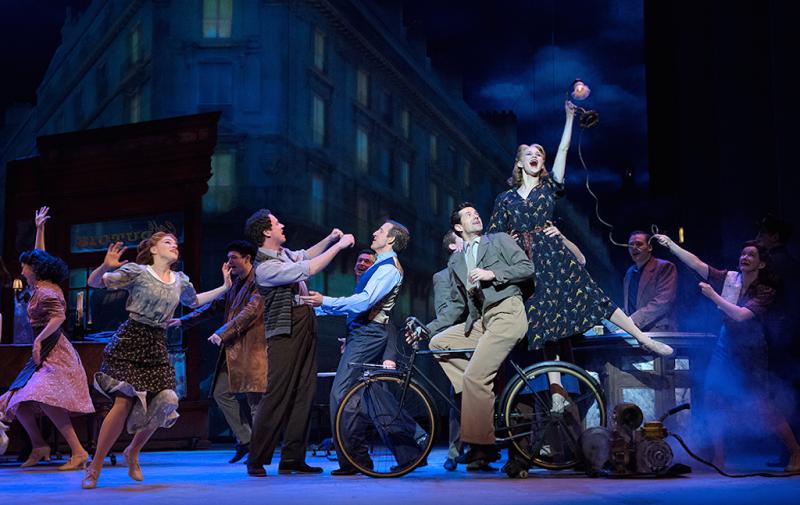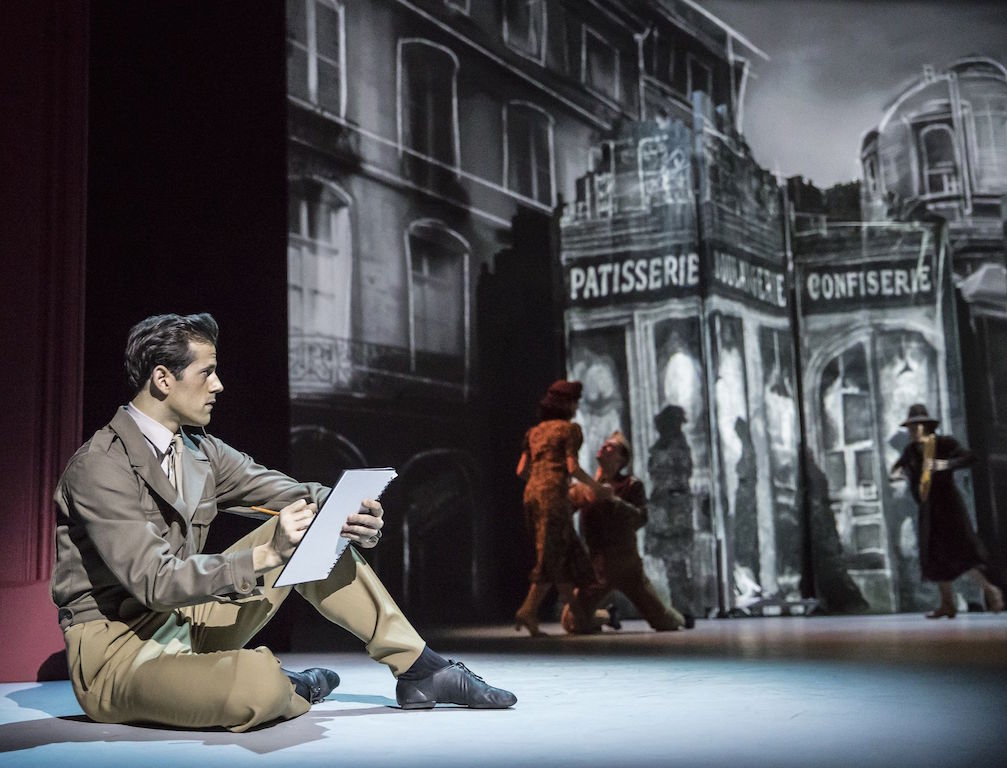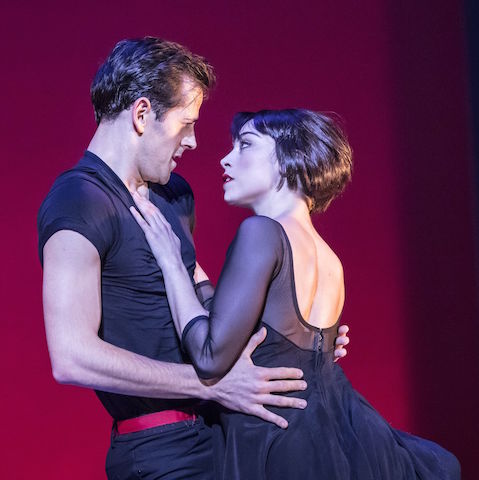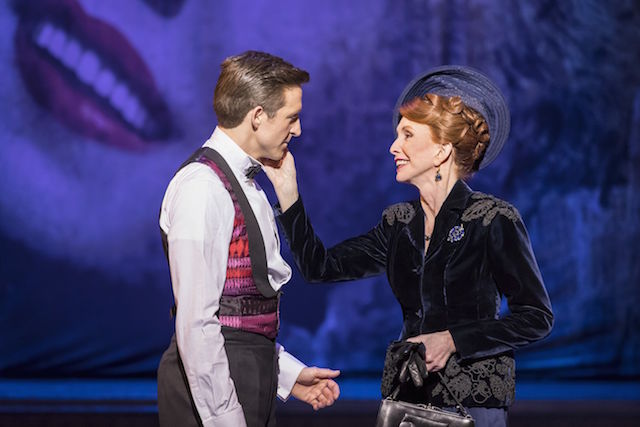An American in Paris review - 'stagecraft couldn't be slicker' | reviews, news & interviews
An American in Paris review - 'stagecraft couldn't be slicker'
An American in Paris review - 'stagecraft couldn't be slicker'
Christopher Wheeldon's staging at the Dominion is the most glamorous escape in town

What’s in a yellow dress? Hope over experience? Reckless confidence? This is a legitimate question when the second big cross-Atlantic people-pleaser hoves into view featuring a girl in a frock of striking daffodil hue. It doesn’t take a degree in semiotics to translate this. Forget the bad stuff, people. C’mon, get happy.
As grand escapism, An American in Paris – a Broadway adaptation of a Hollywood movie-musical – is superb, despite its attempts to introduce a little darkness to the 1951 original. Anyone who remembers the Gene Kelly/Leslie Caron film as flimsy and forgettable should, well, forget that right away. New choreography by Christopher Wheeldon, a new book by Craig Lucas, extra tunes from the Gershwin songbook and two superb ballet-trained leads place this enterprise in an entirely different class. There’s so much to see and to hum, s’wonderful.
 It’s hard to see how stagecraft can get any slicker. The near-wordless prologue packs in such screeds of information that you’re almost breathless before the story is under way. We’re in Paris, the Germans have not long left, and there are bread queues in the streets. Bob Crowley’s grisaille designs (pictured above) have a spontaneous, sketchbook feel, regrouping constantly to create grand boulevards, ruined buildings and shopfronts, as if from a busy pencil. Later, the sets explode into full-colour glamour, with sunsets over the Seine and the perfume department of the Galeries Lafayette.
It’s hard to see how stagecraft can get any slicker. The near-wordless prologue packs in such screeds of information that you’re almost breathless before the story is under way. We’re in Paris, the Germans have not long left, and there are bread queues in the streets. Bob Crowley’s grisaille designs (pictured above) have a spontaneous, sketchbook feel, regrouping constantly to create grand boulevards, ruined buildings and shopfronts, as if from a busy pencil. Later, the sets explode into full-colour glamour, with sunsets over the Seine and the perfume department of the Galeries Lafayette.
The storyline, although much fuller in the new book by Craig Lucas, is essentially unchanged. Newly demobbed Jerry (Robert Fairchild, pictured above, below) spurns the boat home in favour of an uncertain future as an artist. He teams up with fellow Yank Adam, a struggling cabaret composer, and Henri, scion of a Parisian textile firm who secretly longs to be a nightclub crooner. All three are romantically in thrall to Lise (Leanne Cope, pictured below), a shopgirl planning a career as a ballerina. It’s about her that they sing the number “S’Wonderful, S’marvellous”, each unaware of the other’s feelings.
 Choreographer Wheeldon is also the director – his excellent work on the ballet stage makes this no surprise. But if there’s a fault in this dazzling production it’s that he serves up too much at each course. Every scene change, every exchange, is larded with extraneous characters and props. Some of the songs cry out for space to breathe. At the Paris premiere in late 2014 “S’Wonderful” was just three guys in the dark, each in his own spotlight. Now that number is hyperactive, with moving flats each bearing a dancing digital avatar of Lise (as if we didn’t already know the three were mad about her). Perhaps Wheeldon was freaked out by the vastness of the Dominion’s stage and thought he had to fill it.
Choreographer Wheeldon is also the director – his excellent work on the ballet stage makes this no surprise. But if there’s a fault in this dazzling production it’s that he serves up too much at each course. Every scene change, every exchange, is larded with extraneous characters and props. Some of the songs cry out for space to breathe. At the Paris premiere in late 2014 “S’Wonderful” was just three guys in the dark, each in his own spotlight. Now that number is hyperactive, with moving flats each bearing a dancing digital avatar of Lise (as if we didn’t already know the three were mad about her). Perhaps Wheeldon was freaked out by the vastness of the Dominion’s stage and thought he had to fill it.
The choreography, by contrast, is the work of a seasoned master. Wheeldon can turn his hand to anything. He can do vernacular, in a scene where a drab café erupts in a Lindy Hop; he can do old-school hoofing, full top hat and tails, and of course he does classical like a dream. In “Fidgety Feet” – one of the apocryphal Gershwin songs – he shows he can do funny, too. It’s basically a number about going nuts out of boredom at the theatre.
Wheeldon is blessed in his lead performers – but it was no doubt his idea to cast ballet dancers rather than musical-comedy stars. Fairchild is from New York City Ballet, Cope from our own Royal Ballet. Neither has a big voice, but both sing nicely, Cope with a tender little fast vibrato that’s just right for the period. He, meanwhile, wows not only with the lightness and precision of his training, but with a louche recklessness that puts him in the frame with Gene Kelly. Together, Fairchild and Cope are glorious.
 Zoe Rainey, as wealthy dilettante Milo, and Haydn Oakley, as the uptight Henri, have top-class pipes and show us what these can do with a Gershwin tune (“Shall We Dance?”, “Who Cares?”). Yet it’s David Seadon-Young, as the dorkish composer whose physical awkwardness around Lise means he’ll never get close to her, who comes closest to touching us.
Zoe Rainey, as wealthy dilettante Milo, and Haydn Oakley, as the uptight Henri, have top-class pipes and show us what these can do with a Gershwin tune (“Shall We Dance?”, “Who Cares?”). Yet it’s David Seadon-Young, as the dorkish composer whose physical awkwardness around Lise means he’ll never get close to her, who comes closest to touching us.
Two things mar the otherwise witty panache of Craig Lucas’s book. Would Henri’s mother (Jane Asher, pictured above with Oakley) playing the grande dame to the hilt really be voicing doubts about her son’s sexual leanings in 1945? Surely not. And while the addition of wartime references is laudable, tethering the plot to real-life Paris, the big reveal is so lame that it causes something of a dip in the dramatic arc. True, no one goes to An American in Paris expecting The Diary of Anne Frank, but with some adjustments this darker undertow could be made to pull its weight.
- An American in Paris at the Dominion Theatre until 30 September
- More theatre reviews on theartsdesk
The future of Arts Journalism
You can stop theartsdesk.com closing!
We urgently need financing to survive. Our fundraising drive has thus far raised £33,000 but we need to reach £100,000 or we will be forced to close. Please contribute here: https://gofund.me/c3f6033d
And if you can forward this information to anyone who might assist, we’d be grateful.

Subscribe to theartsdesk.com
Thank you for continuing to read our work on theartsdesk.com. For unlimited access to every article in its entirety, including our archive of more than 15,000 pieces, we're asking for £5 per month or £40 per year. We feel it's a very good deal, and hope you do too.
To take a subscription now simply click here.
And if you're looking for that extra gift for a friend or family member, why not treat them to a theartsdesk.com gift subscription?
more Theatre
 Alfred Hitchcock Presents: The Musical, Theatre Royal Bath review - not a screaming success
1950s America feels a lot like 2020s America in this portmanteau show
Alfred Hitchcock Presents: The Musical, Theatre Royal Bath review - not a screaming success
1950s America feels a lot like 2020s America in this portmanteau show
 Wilko: Love and Death and Rock'n'Roll, Southwark Playhouse review - charismatic reincarnation of a rock legend
Johnson Willis captures the anarchic energy and wit of the late guitarist
Wilko: Love and Death and Rock'n'Roll, Southwark Playhouse review - charismatic reincarnation of a rock legend
Johnson Willis captures the anarchic energy and wit of the late guitarist
 Dear England, National Theatre review - extra time for stirring soccer classic
James Graham adds a neat coda to his ode to decency in sport
Dear England, National Theatre review - extra time for stirring soccer classic
James Graham adds a neat coda to his ode to decency in sport
 Weather Girl, Soho Theatre review - the apocalypse as surreal black comedy
A Californian weather girl copes with fires inside and outside her head
Weather Girl, Soho Theatre review - the apocalypse as surreal black comedy
A Californian weather girl copes with fires inside and outside her head
 Clueless: The Musical, Trafalgar Studios review - a perfectly manicured update
KT Tunstall's new score brings bite and momentum to a high octane evening
Clueless: The Musical, Trafalgar Studios review - a perfectly manicured update
KT Tunstall's new score brings bite and momentum to a high octane evening
 The Habits, Hampstead Theatre review - who knows what adventures await?
New play about the game of Dungeons & Dragons explores fact and fantasy
The Habits, Hampstead Theatre review - who knows what adventures await?
New play about the game of Dungeons & Dragons explores fact and fantasy
 Farewell Mister Haffmann, Park Theatre review - French hit of confusing genre, with a real historical villain
Jean-Philippe Daguerre tries to mix a farcical comedy of manners with the Holocaust
Farewell Mister Haffmann, Park Theatre review - French hit of confusing genre, with a real historical villain
Jean-Philippe Daguerre tries to mix a farcical comedy of manners with the Holocaust
 Edward II, RSC, Swan Theatre, Stratford review - monarchs, murder and mayhem from Marlowe
Putsch in the palace brings down a king who chose the wrong person to love
Edward II, RSC, Swan Theatre, Stratford review - monarchs, murder and mayhem from Marlowe
Putsch in the palace brings down a king who chose the wrong person to love
 One Day When We Were Young, Park Theatre review - mini-marvel with a poignant punch
Perfectly judged performances enhance a subtle staging of Nick Payne's two-hander
One Day When We Were Young, Park Theatre review - mini-marvel with a poignant punch
Perfectly judged performances enhance a subtle staging of Nick Payne's two-hander
 Alterations, National Theatre review - high emotional costs of ambition
The Guyanese migrant experience of 1970s London gets the big-stage treatment
Alterations, National Theatre review - high emotional costs of ambition
The Guyanese migrant experience of 1970s London gets the big-stage treatment
 A Knock on the Roof, Royal Court review - poignant account of living under terror
Gaza play is both surreally humorous and finally devastating
A Knock on the Roof, Royal Court review - poignant account of living under terror
Gaza play is both surreally humorous and finally devastating

Add comment